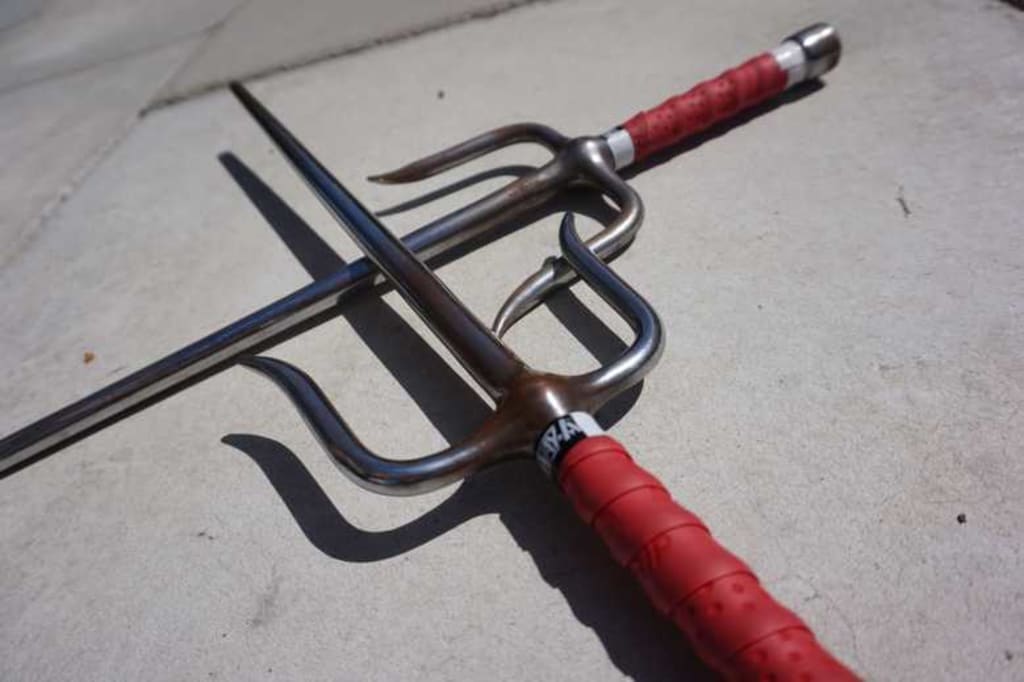Exploring the Timeless Art of the Sai Weapon!
Sai Weapon

The Okinawan martial arts traditions are deeply ingrained in the storied legacy of the sai weapon, which is recognizable by its trident-like design. The humble farming tool that was once the sai has become a symbol of cultural heritage, discipline, and martial skill. Its distinctive design, which combines elegance and functionality, features a central shaft with two curved prongs extending from either side.
The sai, which is well-known for its adaptability in both offensive and defensive techniques, has been an essential component of Okinawan martial arts for centuries. Sai-jutsu practitioners embrace the difficulties and benefits of learning this renowned weapon as they delve into the art and discover a rich tapestry of philosophy, technique, and history.
Origins and History of Sai Weapon
The history and genesis of the sai weapon are intricately linked to Okinawa, Japan's martial arts customs. The sai was first intended to be a basic farming implement for activities like planting, digging, and harvesting. However, over time, it evolved into a powerful weapon for both combat and self-defense. According to scholars, Okinawan social unrest during this time led to the development of the sai as a weapon as farmers looked for ways to defend themselves against invaders and bandits.
Okinawan farmers made the sai into a multipurpose weapon that could parry, strike, and trap the weapons of opponents by inventive adaptations and modifications. The sai was eventually incorporated into training routines and kata (forms) by practitioners of Okinawan martial arts, who used it to become proficient in its use.
As martial arts expanded throughout Okinawa and beyond, the sai became known as a representation of martial skill and a clue to the resourcefulness and fortitude of those who created it. The sai's enduring legacy and timeless appeal are evident in its continued use as a prized artifact of Okinawan culture and as a highly respected weapon in martial artists' armories around the globe.
Anatomy and Design of Sai Weapon
The unique trident-like shape of the sai weapon, which is made up of a central shaft with two curved prongs extending from either side, characterizes both its anatomy and design. Traditionally made of steel or iron, the sai has a rounded handle for gripping and slicing as well as a pointed tip for striking. The yoku, or prongs, are angled strategically to make it possible to effectively trap and immobilize an opponent's weapon. To improve control and give a firm grip in battle, the sai's handle is also usually wrapped in leather or cord.
Sai practitioners can perform a variety of offensive and defensive techniques with grace thanks to the overall design of the sai, which emphasizes speed, agility, and precision. Its lightweight design and small size make it a perfect weapon for close-quarters fighting and quick strikes, and its ergonomic shape allows for smooth technique switching and fluid movement. In the hands of expert martial artists, the sai's ergonomic design and adaptable uses make it a devastating weapon whether used alone or in pairs.
Techniques and Training Methods:
Learning the sai weapon's techniques and training methods is essential to becoming proficient with it for both self-defense and combat. The art of wielding the sai, known as sai-jutsu, requires training methodically to become proficient in a range of techniques, such as throws, blocks, strikes, and traps.
As they gain experience and skill, practitioners advance to more advanced techniques gradually from learning the basic stances, grips, and footwork associated with the sai. In sai-jutsu training, kata, or preset forms, are essential because they give practitioners an organized framework for honing their skills in solo drills. These kata frequently imitate battle scenarios and instruct students on how to react appropriately to various assaults and circumstances.
Students can apply their skills in a dynamic and interactive environment by participating in partner drills and sparring exercises in addition to solo practice. To practice under pressure and simulate real-life combat scenarios, advanced practitioners can investigate scenario-based training and freestyle sparring. Sai-jutsu practitioners acquire the agility, timing, and precision required to use the sai effectively in combat through hard work and training, proving their mastery of this iconic Okinawan martial arts weapon.
Cultural Significance of Sai Weapon!
The sai weapon's cultural significance is profoundly ingrained in Okinawan martial arts traditions, folklore, and identity, and goes beyond its practical uses in combat and self-defense. The sai, a fundamental component of Okinawan martial arts tradition, represents the virtues of honor, discipline, and fortitude that are essential to the warrior ethos.
The sai has been admired throughout history as a representation of martial skill and a clue to the creativity and resourcefulness of those who made it. Its continued legacy and ongoing relevance in the martial arts community are demonstrated by its inclusion in traditional kata and demonstrations. The sai, in addition to its martial uses, has symbolic meaning in Okinawan culture. It symbolizes the people's unwavering dedication to upholding their customs and cultural legacy.
The sai's representation in a variety of media, such as films, TV series, and books, emphasizes its cultural significance even more. These depictions typically feature the sai as the weapon of choice for heroic figures and skilled martial artists. As a cultural icon, the sai weapon is a powerful representation of Okinawan martial arts heritage and the tenacious spirit of its practitioners, inspiring and enthralling martial artists and enthusiasts around the world.
About the Creator
Mai Sophia
A Writer/blogger by day, a knife enthusiast and survivalist by night. I've reviewed a lot of products and have helped people make the right purchase






Comments
There are no comments for this story
Be the first to respond and start the conversation.